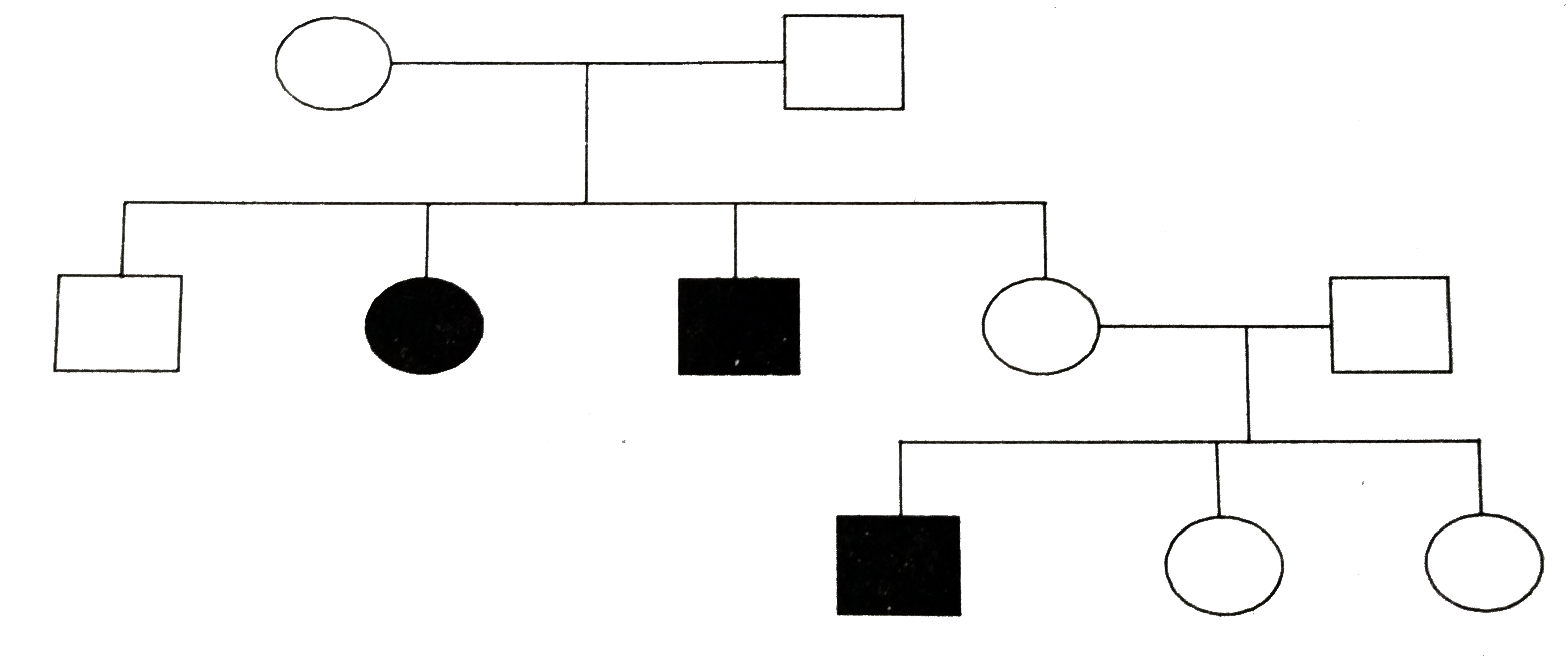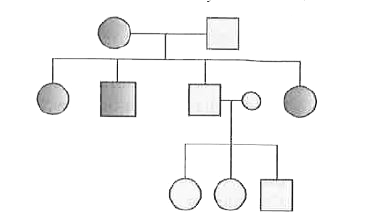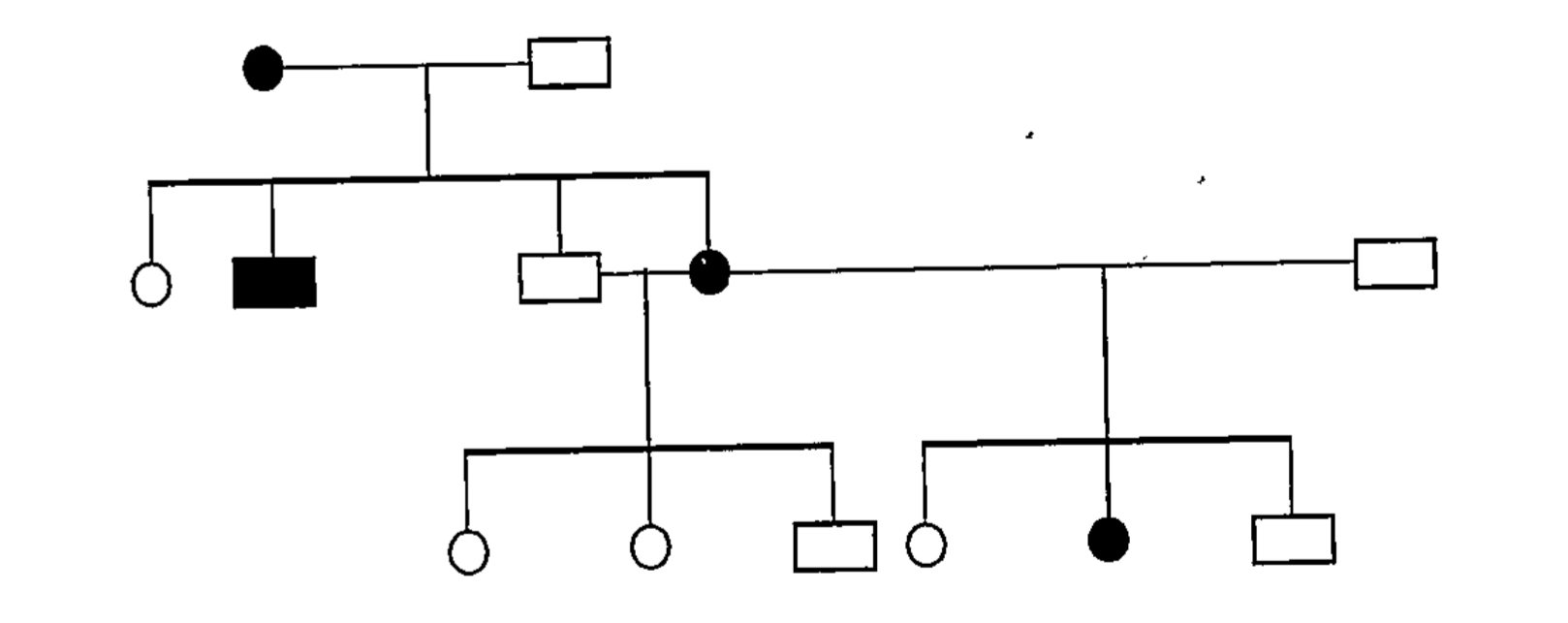Study the given pedigree chart and answer the questions that follow.

Is the trait recessive or dominant?
Is the trait sex linked or autosomal?
Give the genotypes of the parents in generation I and their third and fourth child in generation II. Solution in Kannada
If we take A and a as the traits
Recessive
Autosomal
Parents - Aa and Aa
Third child - aa
Fourth child - Aa
Topper's Solved these Questions
- BOOK - OSWAAL PUBLICATIONCHAPTER - PRINCIPLES OF INHERITANCE AND VARIATIONS EXERCISE - (TOPIC 2 ) (SEX DETERMINATION AND GENETIC DISORDERS (SHORT ANSWER TYPE QUESTIONS-II))6videos
PRINCIPLES OF INHERITANCE AND VARIATIONS
- BOOK - OSWAAL PUBLICATIONCHAPTER - PRINCIPLES OF INHERITANCE AND VARIATIONS EXERCISE - (TOPIC 2 ) (SEX DETERMINATION AND GENETIC DISORDERS (LONG ANSWER TYPE QUESTIONS ))4videos
PRINCIPLES OF INHERITANCE AND VARIATIONS
- BOOK - OSWAAL PUBLICATIONCHAPTER - PRINCIPLES OF INHERITANCE AND VARIATIONS EXERCISE - (TOPIC 2 ) (SEX DETERMINATION AND GENETIC DISORDERS (VERY SHORT ANSWER TYPE QUESTIONS ))16videos
PRINCIPLES OF INHERITANCE AND VARIATIONS
- BOOK - OSWAAL PUBLICATIONCHAPTER - ORGANISMS AND POPUIATIONSEXERCISE - TOPIC :2 Multiple Choice Questions20videos
ORGANISMS AND POPUIATIONS
- BOOK - OSWAAL PUBLICATIONCHAPTER - QUESTION PAPER 2019EXERCISE - PART-D18videos
QUESTION PAPER 2019
Similar Questions
Mention the causes and effects of phenylketonuria.
05:25View SolutionDefine aneuploidy. How is it different from polyploidy ? Describe the individuals having following chromosomal abnormalities.
(a) Trisomy of 21st chromosome
(b) XXX
(c) XO05:25View SolutionKlinefelters syndrome is not seen in human females - give reason.
02:25View SolutionAutecology is the :
03:23View SolutionWhat is megasporogenesis? Explain the development of eight nucleate embryosac in flowering plants.
03:01View SolutionStudy the given pedigree chart and answer the queation that follow.

(a) In the trait recessive or dominant ?
(b) Is the trait sex-linked or autosomal ?
(c) Give the genotypes of the parants in generation I and of their third and fourth child in generation.09:22View SolutionStudy the given pedigree chart and answer the queation that follow. (a) In the trait recessive or dominant ? (b) Is the trait sex-linked or autosomal ? (c) Give the genotypes of the parants in generation I and of their third and fourth child in generation.
05:52View SolutionStudy the given pedigree chart and answer the questions that follow (i) Trait is autosomal recessive (True/False) (ii) Give the genotype of the members 3 and 4.
04:27View SolutionIn the following pedigree chart, state if the trait is autosomal dominant, autosomal recessive or sex linked . Give a reason for your answer.
 03:13View Solution
03:13View SolutionStudy the given pedigree chart and answer the questions that follow. Is the trait recessive or dominant? Is the trait sex linked or autosomal? Give the genotypes of the parents shown in generation I and their III child shown in generation II and the first grandchild shown in generation III.
05:15View SolutionStudy the given pedigree chart and answer the queation that follow.

(a) In the trait recessive or dominant ?
(b) Is the trait sex-linked or autosomal ?
(c) Give the genotypes of the parants in generation I and of their third and fourth child in generation.01:09View SolutionStudy the given pedigree chart and answer the question that follow. (a) In the trait recessive or dominant ? (b) Is the trait sex-linked or autosomal ? (c) Give the genotypes of the parents in generation I and of their third and fourth child in generation.
04:37View SolutionStudy the given pedigree chart and answer the queation that follow.

(a) In the trait recessive or dominant ?
(b) Is the trait sex-linked or autosomal ?
(c) Give the genotypes of the parants in generation I and of their third and fourth child in generation.04:14View SolutionStudy the given pedigree chart and answer the follwing question: Is the trait dominant or recessive
04:13View SolutionIn the following pedigree chart, state if the trait is autosomal dominant, autosomal recessive or sex linked. Give a reason for your answer.
 04:45View Solution
04:45View Solution

